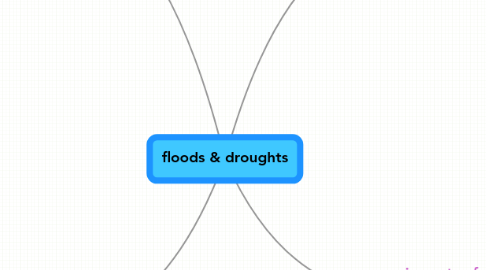
1. causes of floods
1.1. natural
1.1.1. excessive rain
1.1.1.1. tropical monsoon climate
1.1.1.1.1. results in heavy rain
1.1.1.2. e.g China, Yangtze River and Yellow River
1.1.1.2.1. large amount of sediments
1.1.2. storm surges
1.1.2.1. tropical storms
1.1.2.2. strong winds, raise waves
1.1.2.2.1. to exceptionally high levels
1.1.3. melting snow
1.1.3.1. e.g 1986 St John River, Canada could not hold excess water
1.1.3.1.1. several homes submerged
1.1.3.2. cool temperate climate
1.1.3.2.1. melting snow in Spain
1.1.4. global atmospheric processes
1.1.4.1. El Nino
1.1.4.1.1. 3-7 years(several weeks)
1.1.4.1.2. warming of water surface
1.1.4.2. La Nina
1.1.4.2.1. follows after El Nino
1.1.4.2.2. 3-5 years
1.1.4.2.3. south western part of Pacific Ocean
1.1.5. movements of the Earth's surface
1.1.5.1. earthquakes
1.1.5.1.1. landslides
1.1.5.1.2. soil may loosen
1.1.5.1.3. tsunamis
1.2. human
1.2.1. clearing of forests
1.2.1.1. e.g in China, forests are cleared to create land for housing and wood to use as fuels
1.2.1.1.1. hence, loosen soil and is eroded when rain falls
1.2.2. Urbanization
1.2.2.1. with increase of population, built-up areas increase
1.2.2.1.1. concrete pavements and tarred roads, less natural vegetation to intercept rain
1.2.2.2. e.g London, River Thames experience regular flooding
1.2.3. Impacts of enhanced greenhouse effect
1.2.3.1. global warming
1.2.3.1.1. cause climatic changes like higher rainfall in wetter regions
1.2.3.1.2. increase in global temperatures
2. causes of droughts
2.1. natural
2.1.1. insufficient rainfall
2.1.1.1. arid or semi-arid regions
2.1.1.1.1. monsoon winds delayed
2.1.1.2. e.g Bangladesh or India
2.1.2. global atmospheric processes
2.1.2.1. change in rainfall patterns due to natural phenomena
2.1.2.2. El Nino cause droughts in Indonesia and Australia in western Pacific
2.1.2.3. La Nina cause droughts in Peru of eastern Pacific
2.2. human
2.2.1. reduced forest cover
2.2.1.1. lower rates of transpiration
2.2.1.1.1. less water vapour in atmosphere
2.2.1.2. ground exposed to direct heating by Sun and soil dries up quickly
2.2.1.3. e.g deforestation in Amazon rainforest
2.2.2. impact of enhanced greenhouse effect
2.2.2.1. global warming cause droughts in drier regions
2.2.2.2. e.g Sahel, Africa
2.2.2.2.1. high temperatures cause rapid evaporation
2.2.3. overuse of water
2.2.3.1. growing population, more water needed for homes, agriculture and industry
2.2.3.1.1. in some places, people depend heavily on groundwater and rivers to meet water needs
2.2.3.2. e.g since 2001, villagers of Kothariya, India have been experiencing drought
2.2.3.2.1. overuse of water, rivers and wells dried up and livestock affected too
3. impacts of floods
3.1. loss of lives
3.1.1. floods provide fertile land to floodplains
3.1.1.1. attractive to farmers
3.1.1.1.1. densely populated
3.1.2. e.g. 2003 Huai River Basin, Anhui jiangsu, Henan China
3.1.2.1. 298 lives lost and forced people to evacuate
3.2. damage
3.2.1. environment
3.2.1.1. destroy plant lives and natural habitats of animals
3.2.1.2. e.g 17 July 2006, tsunami struck Java and flooded the coastal regions along southern part of island
3.2.1.2.1. cause several damage to coastal ecology
3.2.2. property
3.2.2.1. flood waters submerge villagers and towns
3.2.2.1.1. homes ruined
3.2.2.2. e.g 2005, Hurricane Katrina hit Gulf Coast of USA, lead to massive flooding of several states. damage cost:US$44 billion in total
3.2.3. infrastructure
3.2.3.1. roads become inaccessible
3.2.3.2. power supply and phone lines disrupted
3.2.3.2.1. cut off communication
3.3. spread of diseases
3.3.1. when flooding occurs
3.3.1.1. large no. of homeless victims
3.3.1.1.1. housed in overcrowded makeshift shelters
3.3.2. e.g Dhaka, Bangladesh in July 2004
3.4. fertile soil for agriculture
3.4.1. due to regular flooding of rivers
3.4.1.1. provides soil along river banks with fertile alluvium
3.4.1.1.1. soil suitable for farming
3.4.2. e.g Nile Delta, Egypt
3.4.2.1. crops cultivated because of fertile alluvium deposited by River Nile
4. impacts of droughts
4.1. shortage
4.1.1. food
4.1.1.1. due to lack of water
4.1.1.1.1. animals and people die from dehydration, crops destroyed
4.1.2. water
4.1.2.1. as rivers and lakes dry up when there is a drought
4.1.3. e.g more than 3 million died from starvation and dehydration in mid-1980s due to severe droughts in Sahel region
4.2. damage to environment
4.2.1. in arid and semi-arid regions
4.2.1.1. prolonged droughts cause desertification
4.2.1.1.1. soil in region become very dry
4.2.2. e.g Sahara Desert expanded southwards due to prolonged droughts which began in 1968
4.3. forest fires and hazes
4.3.1. no rain for long time
4.3.1.1. vegetation in forests becomes dry
4.3.1.1.1. catches fire easily
